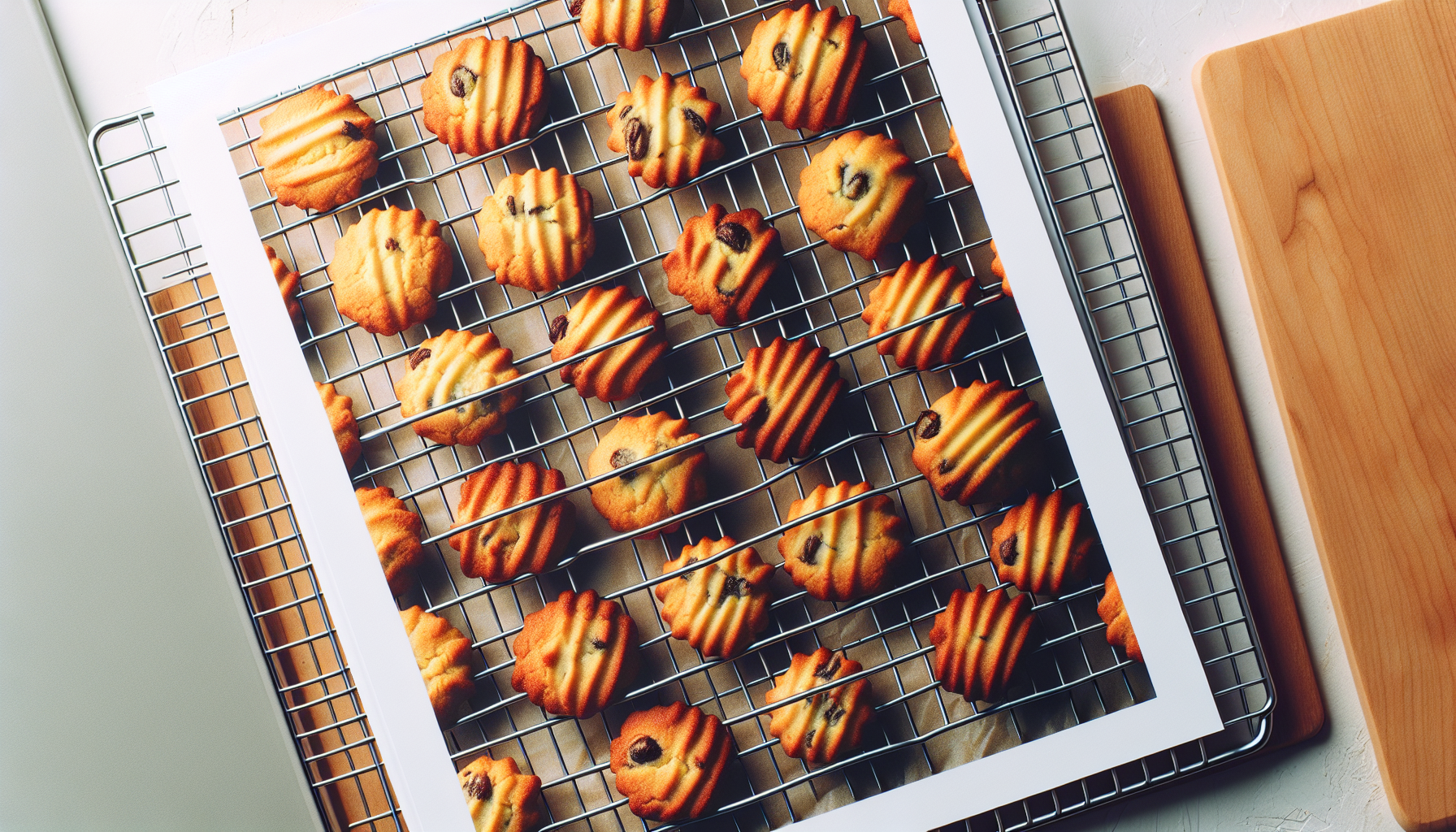Are you an avid baker, always looking for ways to improve your skills and create even more delicious treats? Well, look no further than the convenience of cooling racks in baking. These handy kitchen tools are an essential accessory for any baker, providing a simple yet effective solution to the age-old problem of perfectly cooling your freshly baked creations. In this article, we will explore the benefits of using cooling racks in baking, highlighting how they can greatly enhance your baking experience and deliver even better results. So, let’s dive into the world of baking and discover why every baker should have a cooling rack in their kitchen.

Benefits of using cooling racks
Faster cooling time
When you remove your freshly baked goods from the oven, one of the most important steps in the baking process is allowing them to cool properly. Cooling racks offer the benefit of faster cooling time compared to simply leaving your baked goods on a countertop or cutting board. The elevated design of cooling racks allows air to circulate all around the baked goods, which helps to dissipate heat and cool them more quickly. This means you can enjoy your delicious treats sooner!
Even cooling
In addition to faster cooling time, cooling racks also ensure even cooling of your baked goods. When you place your hot cookies, cakes, or bread on a cooling rack, the air can reach all sides of the baked goods. This prevents uneven cooling and avoids the risk of the bottom side becoming soggy due to trapped steam. With a cooling rack, you can be confident that your baked goods will cool evenly and maintain their ideal texture.
Preventing sogginess
Sogginess is a common issue when it comes to baked goods, especially cookies and fried foods. Cooling racks help to prevent sogginess by allowing proper airflow around your treats. When hot cookies or fried foods are placed directly on a surface, such as a plate or countertop, they can become soggy due to the trapped steam. By elevating them on a cooling rack, the steam can escape and moisture is able to evaporate, keeping your treats crisp, light, and delicious.
Improved air circulation
Cooling racks offer improved air circulation, which is essential for maintaining the quality and texture of your baked goods. When hot baked goods are left to cool on a flat surface, air can only circulate around the top and bottom of the treat. With a cooling rack, air can reach all sides of the baked goods, promoting even cooling and preventing excessive moisture retention. Improved air circulation also helps to enhance the flavors of your baked goods, as they will be exposed to fresh air.
Types of cooling racks
Wire cooling racks
Wire cooling racks are the most common and widely used type of cooling racks. They are made of metal wires intertwined to create a grid pattern. Wire cooling racks are sturdy and durable, able to support the weight of various baked goods. They are also easy to clean and maintain.
Silicone cooling racks
Silicone cooling racks are a modern alternative to traditional wire racks. They are made of heat-resistant silicone material that is flexible and non-stick. Silicone cooling racks are ideal for delicate baked goods that require extra care, as they provide a soft and non-abrasive surface. They are also dishwasher-safe for easy cleaning.
Stackable cooling racks
Stackable cooling racks are a convenient option for those who have limited storage space in their kitchen. These racks can be stacked on top of each other, making them easy to store when not in use. They are typically made of wire or silicone and provide the same benefits of other cooling rack types.
Adjustable cooling racks
If you bake a variety of treats in different sizes, an adjustable cooling rack might be the perfect choice for you. These racks come with movable arms or grids that can be adjusted to accommodate different sizes of baked goods. With an adjustable cooling rack, you can customize the spacing between the bars to ensure proper airflow and cooling for each treat.

Factors to consider when choosing a cooling rack
Material
The material of the cooling rack is an important factor to consider. Wire racks are durable and sturdy, while silicone racks offer a non-stick surface. Think about your baking needs and preferences when choosing between the materials.
Size
Consider the size of the cooling rack in relation to the size of your oven and the types of baked goods you usually make. Ensure that the cooling rack fits comfortably inside your oven and can accommodate the size of your treats without crowding.
Sturdiness
Look for a cooling rack that is sturdy enough to support the weight of your baked goods without bending or warping. A sturdy cooling rack will ensure that your treats cool evenly and prevent accidents such as collapsing cakes or wobbly cookies.
Ease of cleaning
Cleaning a cooling rack after use is an important part of maintenance. Consider the ease of cleaning of the cooling rack, especially if you prefer hand-washing or if you have a dishwasher. Some racks are dishwasher-safe, while others require hand-washing.
Creative uses for cooling racks
Roasting vegetables
Cooling racks are not just for baked goods! When roasting vegetables in the oven, placing them on a cooling rack can help promote even cooking and crispy texture. The elevated design allows hot air to circulate beneath the vegetables, preventing them from becoming soggy. This technique works particularly well for roasted potatoes, Brussels sprouts, and other root vegetables.
Drying herbs
If you enjoy growing your own herbs or have recently purchased a bundle of fresh herbs, a cooling rack can come in handy for drying them. Simply spread the herbs out on the cooling rack and place it in a well-ventilated area. The air circulation provided by the rack will help the herbs dry evenly and quickly, preserving their flavors and aromas.
Draining fried foods
After frying foods such as chicken tenders or onion rings, it’s important to drain excess oil to prevent them from becoming greasy. Placing the fried foods on a cooling rack allows the excess oil to drip away, resulting in a lighter and less oily final product. The air circulation also helps to further cool the hot fried foods.
Icing cakes
When it comes to icing cakes, a cooling rack can be a helpful tool. Place the cake on a cooling rack with a baking sheet or parchment paper underneath to catch any excess icing. By elevating the cake, you have easier access to all sides and can apply the icing evenly and smoothly. The cooling rack also allows any excess icing to drip off, preventing a messy work surface.

Tips for using cooling racks effectively
Use the right size rack
Select a cooling rack that is appropriate for the size of your baked goods. Crowding your treats on a small rack can impede airflow and result in longer cooling times. On the other hand, using a large rack for small treats can cause them to slide around and potentially fall through the gaps.
Allow proper airflow
When placing your baked goods on a cooling rack, be sure to leave enough space between them to allow for proper air circulation. This will prevent condensation and ensure even cooling. If necessary, use multiple cooling racks or stagger the placement of your treats.
Rotate baked goods
To ensure even cooling, it is a good practice to rotate your baked goods during the cooling process. This prevents the bottoms from becoming soggier due to the residual heat from the cooling rack. Simply turn your treats around or switch their positions on the rack after a few minutes of cooling.
Use parchment paper or silicone mats
If you are concerned about your treats sticking to the cooling rack, you can line it with parchment paper or use silicone baking mats. These provide a non-stick surface and make it easier to remove your treats from the rack without causing any damage or leaving residue behind.
Cleaning and maintenance of cooling racks
Hand-washing
For most cooling racks, hand-washing is the preferred method of cleaning. Use warm soapy water and a sponge or soft brush to gently scrub off any residue. Pay attention to any hard-to-reach areas between the wires. Rinse thoroughly and dry the rack completely before storing.
Dishwasher-safe options
If you prefer to use a dishwasher, look for cooling racks that are labeled as dishwasher-safe. These racks can be placed in the dishwasher along with your other kitchenware for convenient cleaning. However, always double-check the manufacturer’s instructions to ensure the rack can handle dishwasher use.
Removing stubborn stains
If your cooling rack develops stubborn stains or baked-on residue, there are a few methods you can try to remove them. Soak the rack in warm soapy water for an extended period of time, then gently scrub with a non-abrasive sponge or brush. Alternatively, you can create a paste using baking soda and water, apply it to the stains, and let it sit for a few minutes before scrubbing.
Storing properly
When not in use, it is important to store your cooling rack properly to prevent damage and prolong its lifespan. Find a dedicated space in your kitchen cabinet or drawer where the rack can be stored flat or, if using a stackable rack, stacked neatly. Avoid placing heavy items on top of the rack, as this can cause the wires to bend.
Recommended cooling racks
KitchenAid Cooling Rack
The KitchenAid Cooling Rack is a reliable and durable choice for all your baking needs. It is made of sturdy stainless steel wire that can withstand high temperatures. The rack is also oven-safe, providing you with the flexibility to cool your treats directly on the rack or transfer them from the oven to the rack for cooling. Its non-stick coating ensures easy release of baked goods and easy cleaning.
Wilton Excelle Elite Cooling Grid
The Wilton Excelle Elite Cooling Grid is another top-notch cooling rack that offers excellent performance. Made of heavy-duty steel, this rack is designed to resist warping and provide even cooling. Its reinforced non-stick coating prevents sticking and makes cleanup a breeze. The grid pattern allows for optimal air circulation, ensuring your treats cool evenly every time.
Bellemain Cooling Rack
The Bellemain Cooling Rack is a versatile and well-designed option. It is constructed with heavy-duty 18-gauge stainless steel wires that are tightly spaced for stability and support. The rack’s crosswire design allows for optimal airflow, promoting even cooling. It is also dishwasher-safe for easy cleaning and has raised feet to elevate the rack and prevent it from scratching your countertops.
OXO Good Grips Non-Stick Pro Cooling Rack
For those who prefer a non-stick cooling rack, the OXO Good Grips Non-Stick Pro Cooling Rack is an excellent choice. It features a durable steel construction with a PFOA-free non-stick coating that ensures easy release of even the stickiest baked goods. The grid pattern provides ample airflow and the rack is oven-safe up to 450°F (232°C). Its reinforced frame and raised feet add stability and prevent wobbling.
Cost-effective alternatives to cooling racks
Wire baking racks
If you don’t have a cooling rack on hand, a wire baking rack can serve as a cost-effective alternative. These racks are typically used for roasting meat or baking cookies, but they can also be used for cooling baked goods. While they may not offer the same level of airflow and precise cooling as a dedicated cooling rack, they can still help prevent sogginess and facilitate faster cooling.
Oven-safe wire cooling racks
Some ovens come with a built-in wire cooling rack that fits perfectly inside the oven. These racks can double as cooling racks when not in use for baking. They provide similar benefits to dedicated cooling racks, such as improved airflow and even cooling. If your oven has a removable cooling rack, it can be a convenient and cost-effective option.
Baking sheets with raised edges
If you have a baking sheet with raised edges, it can also function as a makeshift cooling rack. Simply place your treats on the raised edges, allowing air to circulate underneath. This method works well for large batches of cookies or smaller treats that can be spaced out on the baking sheet. While not as effective as a dedicated cooling rack, it can still help prevent sogginess and provide some cooling benefits.
Common mistakes to avoid when using cooling racks
Overcrowding the rack
One common mistake is overcrowding the cooling rack with too many baked goods. This can impede airflow and result in uneven cooling. Ensure that there is enough space between each treat for air to circulate properly. If you have a large batch of baked goods, consider using multiple cooling racks or cooling them in batches.
Not allowing enough cooling time
Rushing the cooling process can lead to disappointment. It’s important to be patient and allow your baked goods enough time to cool properly. Even if they feel cool to the touch, the internal temperature may still be high. Resist the temptation to dig in right away and give your treats enough time to cool completely for the best texture and flavor.
Using a warped or damaged rack
Inspect your cooling rack before each use to ensure that it is in good condition. Using a warped or damaged rack can result in uneven cooling and may even cause accidents, such as treats sliding through the gaps. If your cooling rack shows signs of wear and tear, consider replacing it to ensure optimal results.
Not properly cleaning and maintaining the rack
Cleaning and maintaining your cooling rack is essential to keep it in good condition and prolong its lifespan. Neglecting to clean the rack thoroughly after use can result in the buildup of residue that is difficult to remove. Additionally, improper storage can lead to the wires bending or warping. Take the time to clean your rack properly and store it in a safe place to ensure its longevity.
Conclusion
Cooling racks are an essential tool in the baking process, offering a multitude of benefits and versatile uses. They facilitate faster cooling times, ensure even cooling, prevent sogginess, and improve air circulation around your treats. When choosing a cooling rack, consider factors such as material, size, sturdiness, and ease of cleaning. If you’re feeling creative, explore the various alternative uses for cooling racks, such as roasting vegetables or drying herbs. Follow the tips for using cooling racks effectively, and consider the recommended cooling racks for your baking needs. Remember to avoid common mistakes and properly clean and maintain your cooling rack for optimal performance. With the convenience of cooling racks, you can enhance your baking experience and enjoy perfectly cooled treats every time.

